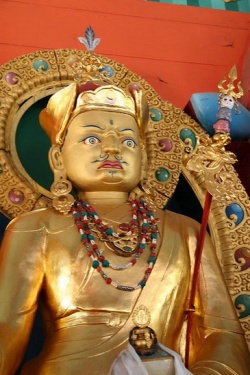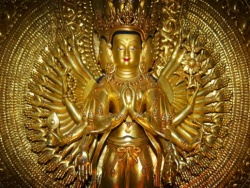Difference between revisions of "The Full Nine Yanas Path"
| Line 1: | Line 1: | ||
[[File:6dfc1c z.jpg|thumb|250px|]] | [[File:6dfc1c z.jpg|thumb|250px|]] | ||
<poem> | <poem> | ||
| − | For those who wish to combine their practice with more thorough study and learn in greater detail about the vast and profound buddhadharma, there is the Full Nine Yanas Path. For as Buddha himself said: | + | For those who wish to combine their practice with more thorough study and learn in greater detail about the vast and profound [[buddhadharma]], there is the Full [[Nine Yanas]] [[Path]]. For as [[Buddha]] himself said: |
| − | Through study we come to understand phenomena. | + | Through study we come to understand [[phenomena]]. |
| − | Through study we turn away from negative actions. | + | Through study we turn away from [[negative actions]]. |
Through study we give up what is meaningless. | Through study we give up what is meaningless. | ||
| − | Through study we reach the state beyond sorrow. | + | Through study we reach the state beyond [[sorrow]]. |
| − | + | —[[Bodhisattva]] [[Pitaka]] | |
| − | Each stage of this graded Nine Yanas path contains detailed study, reflection, and meditation. Not only that, it also covers both the outer and inner tantras, thus covering the entire path to enlightenment from beginning to end, and is based on the blessed treasure teachings of Padmasambhava revealed by Chokgyur Lingpa in the 19th century. | + | Each stage of this graded [[Nine Yanas]] [[path]] contains detailed study, {{Wiki|reflection}}, and [[meditation]]. Not only that, it also covers both the outer and [[inner tantras]], thus covering the entire [[path]] to [[enlightenment]] from beginning to end, and is based on the blessed [[treasure teachings]] of [[Padmasambhava]] revealed by [[Chokgyur Lingpa]] in the 19th century. |
| − | What are the Nine Yanas? | + | What are the [[Nine Yanas]]? |
| − | The Sanskrit word | + | The [[Sanskrit]] [[word]] ‘[[yana]]’ means [[vehicle]], a set of teachings that when practiced ‘carry’ one to the level of [[fruition]]. |
| − | Buddha Shakyamuni gave a huge variety of different teachings in order to tame different sorts of people, who all have their individual capacities and inclinations, yet Buddha also explained that all these different paths and vehicles arrive ultimately at the same point ~ perfect, complete enlightenment. All the different paths that the Buddha taught are complete within the nine yanas. | + | [[Buddha Shakyamuni]] gave a huge variety of different teachings in order to tame different sorts of [[people]], who all have their {{Wiki|individual}} capacities and inclinations, yet [[Buddha]] also explained that all these different [[paths]] and vehicles arrive ultimately at the same point ~ perfect, [[complete enlightenment]]. All the different [[paths]] that the [[Buddha]] taught are complete within the [[nine yanas]]. |
| − | Why practise the Nine Yanas? | + | Why practise the [[Nine Yanas]]? |
| − | Practising the nine yanas gives us an invaluable framework with which to better understand and implement the Buddha’s precious teachings. By studying, contemplating, and meditating in stages like the levels of a staircase, we can gain realization more swiftly. As Buddha taught: | + | Practising the [[nine yanas]] gives us an invaluable framework with which to better understand and implement the [[Buddha’s]] [[precious]] teachings. By studying, contemplating, and [[meditating]] in stages like the levels of a staircase, we can gain [[realization]] more swiftly. As [[Buddha]] taught: |
[[File:657db.jpg|thumb|250px|]] | [[File:657db.jpg|thumb|250px|]] | ||
Just as the steps of a staircase, | Just as the steps of a staircase, | ||
| Line 26: | Line 26: | ||
Just as a small child | Just as a small child | ||
| − | Gradually develops its body and strength, | + | Gradually develops its [[body]] and strength, |
| − | The Dharma is that same way, | + | The [[Dharma]] is that same way, |
From the steps of entering in the beginning | From the steps of entering in the beginning | ||
| − | Up until the complete perfection. | + | Up until the complete [[perfection]]. |
| − | —The Nirvana Sutra | + | —The [[Nirvana Sutra]] |
| − | From among the nine yanas, first come the three outer vehicles, which belong to the sutra teachings: | + | From among the [[nine yanas]], first come the three outer vehicles, which belong to the [[sutra]] teachings: |
| − | Hinayana (The Teachings of the Pali Canon) | + | [[Hinayana]] (The Teachings of the [[Pali Canon]]) |
| − | Path of Renunciation | + | [[Path]] of [[Renunciation]] |
| − | 1. Shravakayana | + | 1. [[Shravakayana]] |
| − | 2. Pratyekabuddhayana | + | 2. [[Pratyekabuddhayana]] |
| − | Mahayana | + | [[Mahayana]] |
| − | 3. Bodhisattvayana | + | 3. [[Bodhisattvayana]] |
| − | Vajrayana | + | [[Vajrayana]] |
| − | Path of Purification | + | [[Path of Purification]] |
[[File:Aaassion.jpg|thumb|250px|]] | [[File:Aaassion.jpg|thumb|250px|]] | ||
| − | Within the Vajrayana, first come the three outer tantras which are based on the sutra teachings, but with a touch of the practice of mantra. These are: | + | Within the [[Vajrayana]], first come the [[three outer tantras]] which are based on the [[sutra]] teachings, but with a {{Wiki|touch}} of the practice of [[mantra]]. These are: |
| − | 4. Kriya Tantra | + | 4. [[Kriya Tantra]] |
| − | 5. Upa Tantra | + | 5. [[Upa Tantra]] |
| − | Path of Transformation | + | [[Path]] of [[Transformation]] |
| − | 6. Yoga Tantra | + | 6. [[Yoga Tantra]] |
| − | The last three yanas within the Vajrayana that employ the powerful, transformative methods of the inner tantras are: | + | The last [[three yanas]] within the [[Vajrayana]] that employ the powerful, transformative methods of the [[inner tantras]] are: |
| − | Path of Transformation | + | [[Path]] of [[Transformation]] |
| − | 7. Mahayoga | + | 7. [[Mahayoga]] |
| − | 8. Anuyoga | + | 8. [[Anuyoga]] |
| − | Path of Self-liberation | + | [[Path]] of [[Self-liberation]] |
| − | 9. Atiyoga | + | 9. [[Atiyoga]] |
| − | The Maha, Anu, and Ati teachings emphasize the skilful means of the development stage, the wisdom of the completion stage, and the non-dual unity of the great perfection, respectively. | + | The [[Maha]], Anu, and Ati teachings {{Wiki|emphasize}} the [[skilful means]] of the [[development stage]], the [[wisdom]] of the [[completion stage]], and the [[non-dual]] {{Wiki|unity}} of the [[great perfection]], respectively. |
| − | Each of the nine yanas has its own unique view, conduct, meditation, and fruition, but they are not completely divorced from one another; each one beautifully clarifies the meaning of the previous one, and prepares the ground for the next. Hence learning the view, conduct, meditation, and fruition of the first vehicle helps clarify the view, meditation, conduct, and fruition of the second, and so forth in an ever-expanding upward spiral. | + | Each of the [[nine yanas]] has its own unique [[view]], conduct, [[meditation]], and [[fruition]], but they are not completely divorced from one another; each one beautifully clarifies the meaning of the previous one, and prepares the ground for the next. Hence {{Wiki|learning}} the [[view]], conduct, [[meditation]], and [[fruition]] of the first [[vehicle]] helps clarify the [[view]], [[meditation]], conduct, and [[fruition]] of the second, and so forth in an ever-expanding upward spiral. |
| − | Phakchok Rinpoche’s teachings on the nine yanas are unusually complete and detailed, following a carefully structured set of study and practice materials. Rinpoche has compiled books for each yana containing a collection of texts by Indian panditas, Tibetan mahasiddhas, and words of the Buddha himself. Using these texts as a basis, during the annual Nine | + | [[Phakchok Rinpoche’s]] teachings on the [[nine yanas]] are unusually complete and detailed, following a carefully structured set of study and practice materials. [[Rinpoche]] has compiled [[books]] for each [[yana]] containing a collection of texts by [[Indian]] [[panditas]], [[Tibetan]] [[mahasiddhas]], and words of the [[Buddha]] himself. Using these texts as a basis, during the annual [[Nine Yanas]]’ [[retreats]] [[Rinpoche]] unravels the [[essence]] of each yana’s meaning and explains in detail how to train in and implement these teachings in all aspects of our [[lives]]. |
| − | Students also receive the empowerments for the specific sadhanas for each yana. These sadhanas belong to the Rigsum Nyingtik (the Heart Essence of the Three Enlightened Families)—a branch teaching of the famous Three Sections of the Great Perfection (Dzogchen Desum) revealed by the great tertön Chokgyur Lingpa. This cycle of sadhanas invokesthe three protectors Avalokiteshvara (compassion), Manjushri(wisdom), and Vajrapani (power) as deities whose form transforms yana by yana. Alongside this sadhana practice, you can also engage in the Four Foundations, the three roots sadhana practice and so on if you wish. | + | Students also receive the [[empowerments]] for the specific [[sadhanas]] for each [[yana]]. These [[sadhanas]] belong to the Rigsum [[Nyingtik]] (the [[Heart Essence]] of the Three [[Enlightened]] Families)—a [[branch teaching]] of the famous Three [[Sections]] of the [[Great Perfection]] ([[Dzogchen Desum]]) revealed by the great [[tertön]] [[Chokgyur Lingpa]]. This cycle of [[sadhanas]] invokesthe three [[protectors]] [[Avalokiteshvara]] ([[compassion]]), Manjushri(wisdom), and [[Vajrapani]] (power) as [[deities]] whose [[form]] transforms [[yana]] by [[yana]]. Alongside this [[sadhana]] practice, you can also engage in the [[Four Foundations]], the [[three roots]] [[sadhana]] practice and so on if you wish. |
| − | Depending on your background, it takes an average of ten to eleven years to complete this entire course after which you will continue to receive further meditation teachings, ever-deepening your practice of Dzogchen (Atiyoga) for the course of your life. | + | Depending on your background, it takes an average of ten to eleven years to complete this entire course after which you will continue to receive further [[meditation]] teachings, ever-deepening your practice of [[Dzogchen]] ([[Atiyoga]]) for the course of your [[life]]. |
</poem> | </poem> | ||
{{R}} | {{R}} | ||
Revision as of 02:43, 11 February 2014
For those who wish to combine their practice with more thorough study and learn in greater detail about the vast and profound buddhadharma, there is the Full Nine Yanas Path. For as Buddha himself said:
Through study we come to understand phenomena.
Through study we turn away from negative actions.
Through study we give up what is meaningless.
Through study we reach the state beyond sorrow.
—Bodhisattva Pitaka
Each stage of this graded Nine Yanas path contains detailed study, reflection, and meditation. Not only that, it also covers both the outer and inner tantras, thus covering the entire path to enlightenment from beginning to end, and is based on the blessed treasure teachings of Padmasambhava revealed by Chokgyur Lingpa in the 19th century.
What are the Nine Yanas?
The Sanskrit word ‘yana’ means vehicle, a set of teachings that when practiced ‘carry’ one to the level of fruition.
Buddha Shakyamuni gave a huge variety of different teachings in order to tame different sorts of people, who all have their individual capacities and inclinations, yet Buddha also explained that all these different paths and vehicles arrive ultimately at the same point ~ perfect, complete enlightenment. All the different paths that the Buddha taught are complete within the nine yanas.
Why practise the Nine Yanas?
Practising the nine yanas gives us an invaluable framework with which to better understand and implement the Buddha’s precious teachings. By studying, contemplating, and meditating in stages like the levels of a staircase, we can gain realization more swiftly. As Buddha taught:
Just as the steps of a staircase,
You should also train step-by-step
And endeavor in my profound teachings;
Without jumping the steps, proceed gradually to the end.
Just as a small child
Gradually develops its body and strength,
The Dharma is that same way,
From the steps of entering in the beginning
Up until the complete perfection.
—The Nirvana Sutra
From among the nine yanas, first come the three outer vehicles, which belong to the sutra teachings:
Hinayana (The Teachings of the Pali Canon)
Path of Renunciation
1. Shravakayana
2. Pratyekabuddhayana
Mahayana
3. Bodhisattvayana
Vajrayana
Path of Purification
Within the Vajrayana, first come the three outer tantras which are based on the sutra teachings, but with a touch of the practice of mantra. These are:
4. Kriya Tantra
5. Upa Tantra
Path of Transformation
6. Yoga Tantra
The last three yanas within the Vajrayana that employ the powerful, transformative methods of the inner tantras are:
Path of Transformation
7. Mahayoga
8. Anuyoga
Path of Self-liberation
9. Atiyoga
The Maha, Anu, and Ati teachings emphasize the skilful means of the development stage, the wisdom of the completion stage, and the non-dual unity of the great perfection, respectively.
Each of the nine yanas has its own unique view, conduct, meditation, and fruition, but they are not completely divorced from one another; each one beautifully clarifies the meaning of the previous one, and prepares the ground for the next. Hence learning the view, conduct, meditation, and fruition of the first vehicle helps clarify the view, meditation, conduct, and fruition of the second, and so forth in an ever-expanding upward spiral.
Phakchok Rinpoche’s teachings on the nine yanas are unusually complete and detailed, following a carefully structured set of study and practice materials. Rinpoche has compiled books for each yana containing a collection of texts by Indian panditas, Tibetan mahasiddhas, and words of the Buddha himself. Using these texts as a basis, during the annual Nine Yanas’ retreats Rinpoche unravels the essence of each yana’s meaning and explains in detail how to train in and implement these teachings in all aspects of our lives.
Students also receive the empowerments for the specific sadhanas for each yana. These sadhanas belong to the Rigsum Nyingtik (the Heart Essence of the Three Enlightened Families)—a branch teaching of the famous Three Sections of the Great Perfection (Dzogchen Desum) revealed by the great tertön Chokgyur Lingpa. This cycle of sadhanas invokesthe three protectors Avalokiteshvara (compassion), Manjushri(wisdom), and Vajrapani (power) as deities whose form transforms yana by yana. Alongside this sadhana practice, you can also engage in the Four Foundations, the three roots sadhana practice and so on if you wish.
Depending on your background, it takes an average of ten to eleven years to complete this entire course after which you will continue to receive further meditation teachings, ever-deepening your practice of Dzogchen (Atiyoga) for the course of your life.


